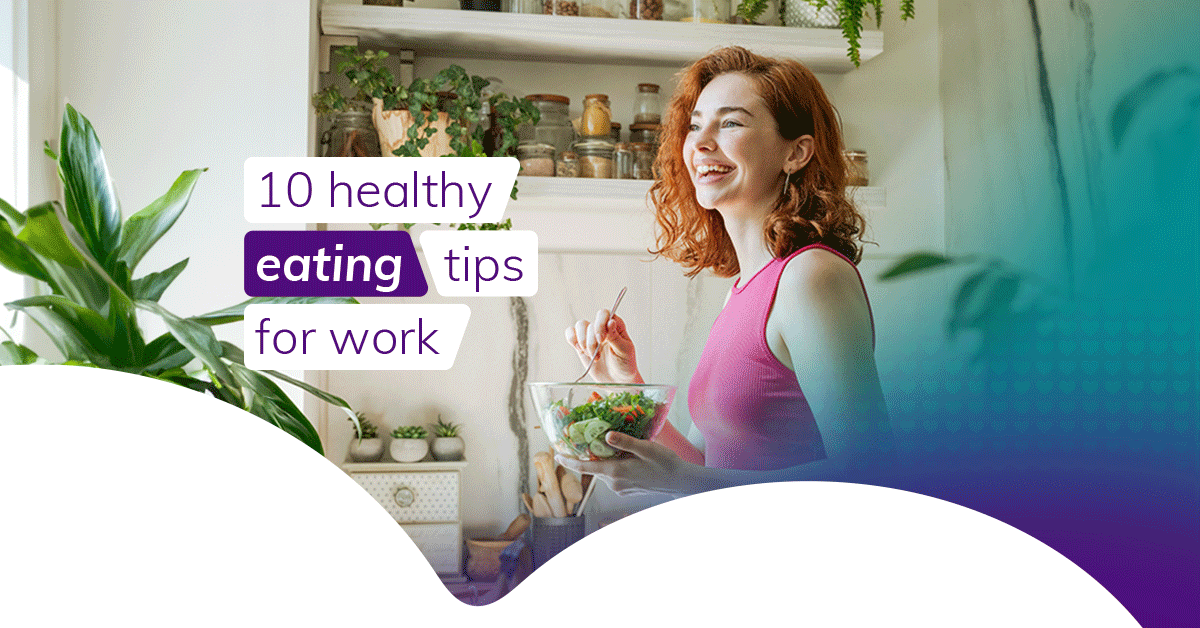

'Don't multitask at mealtime!': 10 healthy eating tips for work
From ways to curb unhealthy snacking to the importance of eating with others, Vhi Health Coach Micheli Romão explains how you can take care of your nutrition while you take care of business.
With work making up such a significant slice of our daily lives, we can't put our wellbeing on hold during business hours. That includes nutrition; nowadays we know the importance of a well-balanced diet for our overall health, from mitigating against disease to boosting our brain power. And yet, so often, I hear people say things like 'I don't have the time to have lunch', as it becomes the first thing to slip down our list of priorities.
There are plenty of demands on you during the working day, but a little planning can genuinely help you prioritise healthy eating without adding undue stress. In fact, it should ease your stress in the long run. To get you started, here are 10 tips on how to eat healthy at work, whether you’ve the laptop out at home or are heading into the office.
1. Preparation, preparation, preparation
Before you clock in or log on, start with a shopping list. Setting out your meals for the entire week really does pay off. By getting it sorted in one chunk of time, you can ensure all your needs are being met. You also avoid grabbing whatever unhealthy food you can get your hands on when you're low on time and options later in the week. Start by deciding on your dinners – I always prioritise home cooking and match the complexity of preparation with how busy I expect to be. Healthy, substantial dinners will also take care of your lunch too, as you maximise your leftovers the following day.
In terms of a menu, it's not about getting fancy with your recipes. Just become aware of the basic food groups and follow the simple equation: you need protein, wholegrain and two greens or vegetables. Make a list, check those boxes, and pretty soon you'll have the makings of a whole array of achievable meals from those building blocks.
2. Plan your eating times
Regardless of where you're working, schedule breaks throughout the day that align with your work tasks. Set reminders to stick to them and help curb overeating. Bear in mind that we don't want to get all of our nutrition in huge chunks.
Instead, maintain your energy levels at a consistent rate across the day. So, the goal is to eat every 3 to 4 hours so you can digest your food at the optimal pace and keep your blood sugar consistent.
There are some guidelines you can follow and tailor to your own circumstances:
- Within an hour of waking up, you're ready to build energy. A high protein, low sugar and carb breakfast will provide long-lasting energy without a mid-morning crash. Try porridge with fresh fruit or an omelette with spinach.
- A low-calorie snack three hours later will tide you over until lunch. Slices of apple with unsweetened yoghurt are ideal.
- Around noon, or five hours after breakfast, have a lunch that focuses on proteins, along with complex carbs, healthy fats, and fibre. For example, fish such as salmon (or a plant-based alternative) with broccoli and brown rice.
- A light, low-calorie snack, like unsalted nuts, will alleviate afternoon hunger around three hours after lunch.
- Try to have your day's final meal no less than three hours before bed. Include a protein, complex carbs, fruits, and vegetables. Chicken breast or tofu, with wholegrain noodles, spinach and diced tomato is one such simple dish.
3. Create obstacles to unhealthy eating at work
If you find yourself constantly snacking, it's time to clear out the temptation. Clear your desk and drawers of any treats. Remove that easy access. In terms of the home, either throw away all those sugary, processed snacks, or at least put them in a box that's out of sight and out of reach. Even adding one layer of difficulty will have a big effect.
At the same time, make it easier to grab a healthy alternative as you make a beeline for temptation! Have healthy snacks in close reach, vegetables at eye levels, fruits on the table. If a banana's the only thing available, you'll have it. This goes back to the shopping list: nip temptation in the bud by sticking to healthy items. So, if you do end up craving a digestive biscuit, you're unlikely to want it so much that you stop everything and drive to the shop to buy them. All these little behaviour strategies help, regardless of the environment. If you've apples and bananas in the canteen, they'll become your default snacks. Packed lunches are great for removing the uncertainty of eating out and the potential pitfalls of settling for something of little nutritional value.
4. Snack right
At the same time, accept that you're going to snack. Just make sure you do it at set times, rather than constantly grazing. And have that planned snack even if you're not hungry, because if let yourself go hungry later, you can lose control of what you eat.
We've already established that having alternatives nearby is helpful. But you need to make sure they're meeting all your needs.
Food is an experience that involves our tastebuds and a host of other sensory aspects. I remember talking to a client about their issues with stress eating, and they told me that they really loved eating crisps at their desk. So, I began to unpack exactly what they loved about it. First came the saltiness. And then they mentioned the crunch – they liked the noise it made, because it helped reduce their stress.
That was a big insight and totally informed our choice of a substitute. We knew we were looking for healthy snacks with the same noise. So dipping celery into hummus, or apple with some peanut butter. Making sure that stress-busting crunch was still there.
5. Understand the post-lunch slump
If you tend to lose energy and feel out-of-sorts when you come back from lunch, simple carbohydrates are one major culprit. These kinds of carbs, found in sugary foods and baked goods like white bread, are quickly digested and cause a short spike in energy. Aim for complex carbs instead. So brown rice instead of white rice, for instance.
There’s also an essential amino acid called tryptophan in foods like turkey, chicken, oats, and cheese which helps produce serotonin and melatonin, but can make you slightly drowsy in the short-term.
Big lunches can also be to blame – there’s blood rushing to your gut to aid with all this heavy digestion, meaning your brain functioning isn’t being quite as prioritised! So, reducing your lunch portions can help, regardless of the food type.
There are several other factors that cause this slump. Most of us will simply be due a natural energy dip as our circadian rhythm causes a drop in core body temperature that releases a small amount of melatonin, the sleep hormone. But you can stop food exacerbating the problem.
6. Mind your liquids
Research shows that even low levels of dehydration (as little as 1-4%) can cause headaches and poor concentration. It’s recommended that you have 6 to 8 daily glasses of water.
Tea or coffee can count towards this fluid intake. You might have heard that caffeine will mean you urinating more frequently, leading to dehydration, though consuming moderate amounts shouldn’t affect you in this regard.
But what’s a moderate amount? Caffeine will impact some people more than others, of course, but 400 daily milligrams is often cited as a safe daily amount. That amounts to roughly four cups of coffee. If you’re looking to cut down on your caffeine, green tea is a good option, containing around 33 mg per cup. It will also give you natural antioxidants that help prevent cell damage and are great for brain function.
If you’re looking for a drink to boost your energy, I’d avoid sports or energy drinks. You’re generally just getting water and a lot of sugar. For a real energy drink, have a shot of ginger! Along with acting as a natural stimulant, ginger can also ease soreness and muscle pain.
7. Avoid desk eating
If you’re particularly busy, it can be tempting to “power through” and eat lunch while staring at a screen. Make a concerted effort to use eating time as an opportunity to get away from your desk. First of all, desk eating isn’t the most hygienic of practices. You’re tapping away at your keyboard or answering the phone in between mouthfuls and potentially taking in some nasty bacteria. There’s even research to show that it leads to ingesting chemicals like flame retardants from your computer and equipment.
So, make a habit of getting up and washing your hands before you eat. Then, try to find a fresh location, whether that’s your own kitchen or the office canteen. If the weather permits, taking your food to a local park will give you some much needed fresh air and get the blood flowing. You’re looking for a proper mental rest and the physical act of going for lunch will give you that. It allows parts of your brain to recharge and will only improve your productivity when you return. Give yourself at least 15 to 20 minutes, so you don't fall into the habit of mindless eating while working, which can reduce satisfaction and lead to overeating.
8. Aim for communal eating
If you’re constantly eating alone, your health can be negatively impacted. You’re missing out on the social connection we are hardwired to look for at mealtimes. Research shows that food acts as a social glue and is super effective for building a sense of camaraderie. Sadly, we're becoming very individualistic. We work in pods. And even the food is wrapped up and packaged individually!
If we take our cues from “blue zone” countries – parts of the world where people age particularly well – most of their meals are shared. There’s a cultural emphasis on eating together and fostering a sense of belonging to a wider community is really important. So, if you’re in the office, lunch should be your window of opportunity for a proper catch-up with colleagues in the canteen. If you’re a parent working from home, it can be quality time with the kids if you can manage to sync your meals.
9. Try to eat more mindfully
What we eat becomes part of us. It's truly profound when we understand that connection on a cellular level. Many of us have already lost our connection with where our food comes from and how it’s produced. That alone impacts how healthily we eat. Indigenous tribes, for example, will naturally eat in a very portion-controlled way because they operate seasonally and have a deep understanding of how much they can produce.
We know that eating is something to be experienced, rather just a simple biological necessity to get over and done with. With mindful eating, you fully focus on the meal in front of you, observing the taste, texture, and smell with every bite. The sensory power of all of that will bring you into the moment, which really is a form of meditation and great for your wellbeing. When you’re eating, just eat. Mealtime is not multitasking.
10. Make the most of WFH
Aside from ways to eat healthy at the office, remote working presents its own opportunities and challenges. You’ll likely have more time to prepare and schedule your meals. Even that lack of a commute either side of work can create windows for communal eating. You’re also fully in control of what food is available to you and don’t have to rely on office facilities.
Of course, that control can be a double-edged sword! There will be greater temptation and an increased potential for ‘grazing’, where you’re just constantly snacking without thinking about it. Often, it’s a form of stress eating. Those aforementioned ‘obstacles’ to snacking come into play here. If you can help it, avoid working near or in the kitchen. Remote working can also lead to solitary meals, so you might need to make that extra effort to make plans with a friend and meet them on your break. Or perhaps hybrid working gives you those couple of days to connect in the office each week.
Food for thought
Those tips aside, we do see how employers are starting to support healthy eating at work. With many companies placing an emphasis on ‘brain capital’ – that belief that our mental health and cognitive skills are our greatest assets – nurturing employee wellbeing is more important than ever before. Seminars, classes and demonstrations on nutrition and cooking can be invaluable in providing strategies for eating healthier at work. As can having a dedicated space to eat, or nutritious eating options that are widely available and convenient.
There is so much at stake when we are at work: our value as a professional, our earnings, our ability to pay the mortgage, look after the kids. So, it makes a huge difference when a company understands what work means for your overall health. Of course, personal behaviour can’t change without the individual wanting it themselves. We all need to do more to facilitate healthy eating at work. And that starts with you.
For information on our online dietician service for Vhi members, take a look at our Digital Health Services page.
This content is for information purposes only and is not intended or implied to be a substitute for professional medical advice, diagnosis or treatment. Always seek advice from your GP or an appropriate medical professional if you have concerns about your health, or before commencing a new healthcare regime. If you believe that you are experiencing a medical emergency call 999 / 112 or seek emergency assistance immediately.

.jpg/_jcr_content/renditions/cq5dam.web.1280.1280.jpeg?ch_ck=1699631419000)
